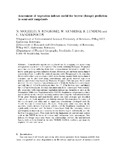Please use this identifier to cite or link to this item:
http://hdl.handle.net/10311/410| Title: | Assessment of vegetation indexes useful for browse (forage) prediction in semi-arid rangelands |
| Authors: | Moleele, N. Ringrose, S. Arnberg, W. Lunden, B. Vanderpost, C. |
| Issue Date: | 2001 |
| Publisher: | Taylor and Francis http://www.clas.ufl.edu/lueci/southworth/RS-class-advanced/Discussion-readings/Moleele%20et%20al%202001%20Assessment%20of%20veg%20indexes%20i.pdf |
| Citation: | Moleele N. et al (2001) Assessment of vegetation indexes useful for browse (forage) prediction in semi-arid rangelands, International Journal of Remote Sensing, vol. 22, no. 5, pp. 741-756. |
| Abstract: | Considerable signi® cance is placed on the mapping and monitoring of degraded areas in semi-arid regions of the world, including Botswana. Degraded areas include those suVering from bush encroachment, believed to result from heavy cattle grazing over a number of years. However, certain bush encroachment species have been found to be relatively nutrient-rich.The present work considers the extent to which a series of quanti® ed layers throughmainly bush encroachment canopies can be identi® ed using conventional and newly derived vegetation indexes and transforms based on Thematic Mapper (TM) imagery. Field work involved the strati® cation of green biomass into ® rstly the herbaceous cover layer; secondly the 0.3± 1.5m browse layer; then the 1.5± 2.5m browse layer; and ® nally the >2.5m browse layer. Biomass measurements from these layers were statistically associated with conventional vegetation indexes and transforms such as the NormalizedDiVerenceVegetation Index (NDVI), brightness and greenness values, and relatively newly derived darkening indexes involving the mid-infrared bands. When green biomass and transformed pixel data were averaged per classi® ed vegetation unit, weak negative correlations emerged between grass biomass and the transformed pixel data and no signi® cant correlations developed with the woody biomass (browse) layers. However, when point data were used in the analyses, results showed that most indexes and the brightness transform were signi® cantly correlated with the lower browse layer. Only the darkening indexes and brightness function were sensitive to the browse layers individually and the browse plus grass layers. This work shows the limitations of conventional indexes such as the NDVI in terms of browse and herbaceous layer assessment. New indexes for forage assessment based on relationships between the mid-infrared bands, such as those found in the new MODIS TERRA platform, are urgently required for semi-arid areas. |
| URI: | http://hdl.handle.net/10311/410 |
| ISSN: | 0143 1161 |
| Appears in Collections: | Research articles (Dept of Environmental Science) |
Files in This Item:
| File | Description | Size | Format | |
|---|---|---|---|---|
| Moleele_IJRS_2001.pdf | 882.58 kB | Adobe PDF |  View/Open |
Items in DSpace are protected by copyright, with all rights reserved, unless otherwise indicated.
